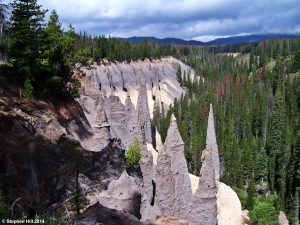THE OTHER GRAND CANYON
Almost everyone over the age of six has heard of the Grand Canyon and most upon learning about it wish to pay this national park a visit and for very good reasons. The immensity of the divide coupled with the charms of the southwest and the wide open skies draw the visitor in. It is gracious in its enormity. But I know a secret. The vast numbers of yearly visitors, 4.5 million in 2013, tend to gather along the canyon’s developed south rim. This makes sense given the ease of access from several nearby interstates, fairly mild weather and even train service on the Grand Canyon Railway. But, on summer days this can make a walk along the popular sections of the South Rim something akin to visiting a shopping mall or a busy downtown avenue. While it is true that you can escape into solitude by being one of the less than 2% of visitors who venture into the back country; however, there is another way to enjoy the canyon with breathtaking views almost to yourself…visit the park’s North Rim.
You approach the North Rim from, well the north, after passing through the tiny resort area of Jacob Lake. It is just a 45 mile scenic drive to the park’s entrance from there. Once in the park you have the opportunity to visit quiet scenic pull-outs, enjoy plentiful wildlife and relax in the cooler temperatures that come with being 1000 feet higher than the South Rim. Visiting the North Rim does require some planning as it is not a day trip – unless the idea of driving throughout the night excites you. Lodging is available in either Jacob Lake (camping, cabins or lodge), at a few other camping facilities or within the park itself. There are only a small number of beds, camping spaces and cabins so its wise to book ahead.
The North Rim has many of the same activities of it’s southern cousin, hiking, horseback riding, ranger talks, souvenirs, mule rides, sunsets, sunrises, good eats, archaeology, history and a wonderful scenic drive, but with fewer people. Somehow the buttes and cliffs within the canyon seem closer. Perhaps it is that the air is a bit clearer higher up. But be warned, there is also less time to enjoy these activities since summer is short on the North Rim. The park usually opens to cars in mid-May and then closes again in mid-October when snow begins to fly. Winters along the North Rim can come with upwards of 12 feet of snow and access is limited.
Regarding your time at the North Rim, I suggest using a good and recent guidebook to plan your drive and expeditions. Most books will advise you to drive the Cape Royal Road and I think it best to start this drive early in the day. First drive all the way to the end and start your viewing at Cape Royal. Catch the canyon in the morning for the best light and do take a walk out onto the peninsula and over Angel’s Window. On the way back there are plenty of chances to pull-out for a photo, hike or picnic. Be sure to bring something to eat and drink with you as there is no food available along the drive. Consider hitting the main visitor’s center or Jacob Lake’s store to stock up on lunch provisions. Stop and visit the Walhalla Ruins on your way back and then drive out to Point Imperial to top off your day. It can be magical along the rim at night with excellent star gazing, but watch for deer, elk and even bison when driving back.
There’s far more to write about regarding the North Rim experience and a small blog post cannot do it justice. I invite you to explore this lesser known region of the Grand Canyon National Park. It is only 3.5 scenic hours from Las Vegas and 3 hours from Flagstaff. Wonderfully not close any large city and beautifully located within some of the most inspiring landscapes in the world. Although the visitor center and lodge can seem crowded during the day due to the fact they are smaller than at most large national parks, the smaller crowds along the trails, roads and view points give the area a friendly appeal and set a relaxing tone. There are even rocking chairs placed outside on the main lodge’s patio for enjoying the view and getting to know your fellow visitors. Plus, when you tell your friends and family about your visit to this most famous national park, you’ll have your own secret to share.


















































